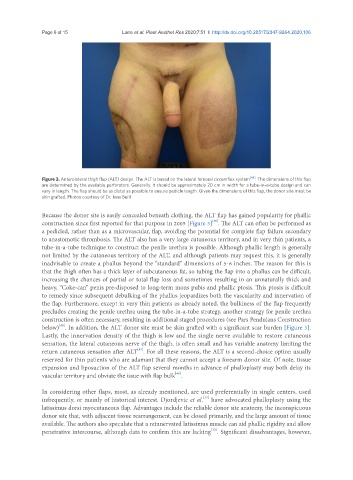Page 590 - Read Online
P. 590
Page 6 of 15 Lane et al. Plast Aesthet Res 2020;7:51 I http://dx.doi.org/10.20517/2347-9264.2020.106
Figure 3. Anterolateral thigh flap (ALT) design. The ALT is based on the lateral femoral circumflex system [48] . The dimensions of this flap
are determined by the available perforators. Generally, it should be approximately 20 cm in width for a tube-in-a-tube design and can
vary in length. The flap should be as distal as possible to ensure pedicle length. Given the dimensions of this flap, the donor site must be
skin grafted. Photos courtesy of Dr. Jens Berli
Because the donor site is easily concealed beneath clothing, the ALT flap has gained popularity for phallic
[45]
construction since first reported for that purpose in 2005 [Figure 3] . The ALT can often be performed as
a pedicled, rather than as a microvascular, flap, avoiding the potential for complete flap failure secondary
to anastomotic thrombosis. The ALT also has a very large cutaneous territory, and in very thin patients, a
tube-in-a-tube technique to construct the penile urethra is possible. Although phallic length is generally
not limited by the cutaneous territory of the ALT, and although patients may request this, it is generally
inadvisable to create a phallus beyond the “standard” dimensions of 5-6 inches. The reason for this is
that the thigh often has a thick layer of subcutaneous fat, so tubing the flap into a phallus can be difficult,
increasing the chances of partial or total flap loss and sometimes resulting in an unnaturally thick and
heavy, “Coke-can” penis pre-disposed to long-term mons pubis and phallic ptosis. This ptosis is difficult
to remedy since subsequent debulking of the phallus jeopardizes both the vascularity and innervation of
the flap. Furthermore, except in very thin patients as already noted, the bulkiness of the flap frequently
precludes creating the penile urethra using the tube-in-a-tube strategy, another strategy for penile urethra
construction is often necessary, resulting in additional staged procedures (see Pars Pendulans Construction
[46]
below) . In addition, the ALT donor site must be skin grafted with a significant scar burden [Figure 3].
Lastly, the innervation density of the thigh is low and the single nerve available to restore cutaneous
sensation, the lateral cutaneous nerve of the thigh, is often small and has variable anatomy limiting the
[47]
return cutaneous sensation after ALT . For all these reasons, the ALT is a second-choice option usually
reserved for thin patients who are adamant that they cannot accept a forearm donor site. Of note, tissue
expansion and liposuction of the ALT flap several months in advance of phalloplasty may both delay its
[48]
vascular territory and obviate the issue with flap bulk .
In considering other flaps, most, as already mentioned, are used preferentially in single centers, used
[32]
infrequently, or mainly of historical interest. Djordjevic et al. have advocated phalloplasty using the
latissimus dorsi myocutaneous flap. Advantages include the reliable donor site anatomy, the inconspicuous
donor site that, with adjacent tissue rearrangement, can be closed primarily, and the large amount of tissue
available. The authors also speculate that a reinnervated latissimus muscle can aid phallic rigidity and allow
penetrative intercourse, although data to confirm this are lacking . Significant disadvantages, however,
[32]

